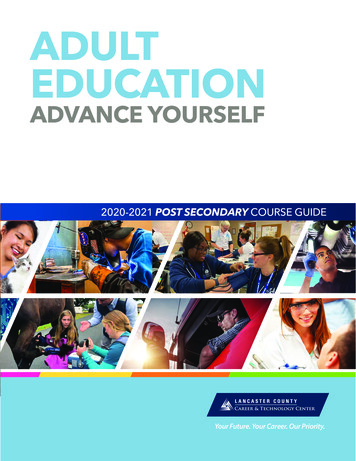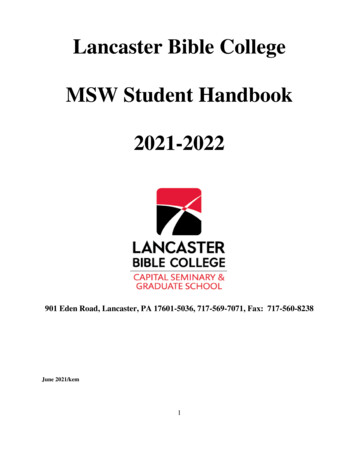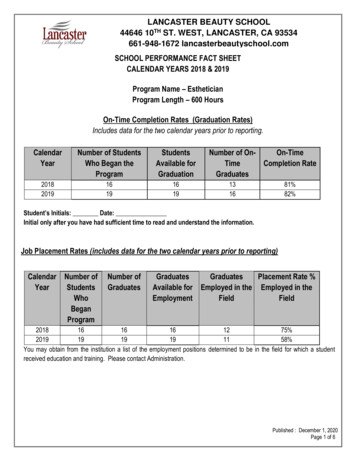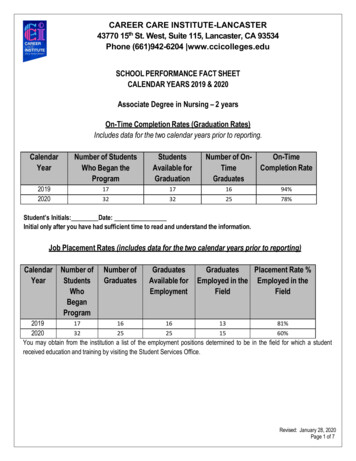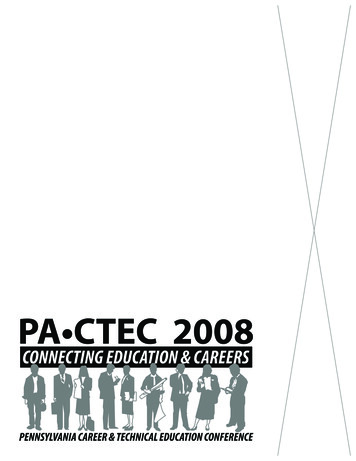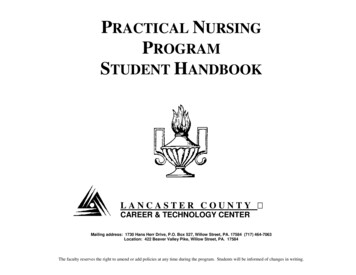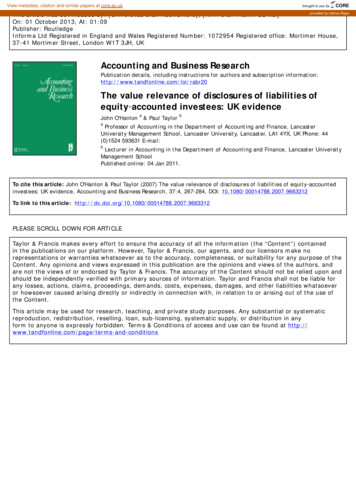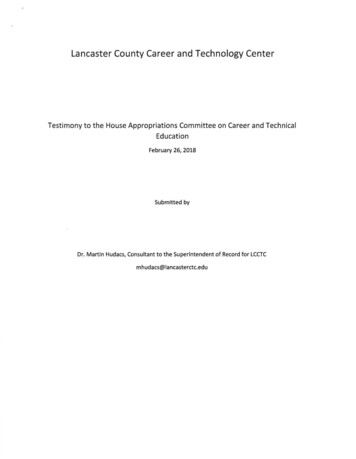
Transcription
Lancaster County Career and Technology CenterTestimony to the House Appropriations Committee on Career and TechnicalEducationFebruary 26, 2018Submitted byDr. Martin Hudacs, Consultant to the Superintendent of Record for LCCTCmhudacs@lancasterctc.edu
We appreciate the opportunity to address the impact that Career and Technology Education (CTE) canhave on workforce development, as well as to identify some concerns that directly impact the careerand technology schools throughout Pennsylvania. We are certainly willing to be part of the solution,and we offer our time and expertise in any way you might find helpful in addressing these concerns.Thank you for your interest and support in the work done at the Lancaster County Career and TechnicalCenter (LCCTC). We are very proud of our staff and students, and we take great pride in theiraccomplishments, including the recent recognition by Forbes Magazine as a leader in career andtechnical education.We recognize that career and technical education (CTE) is at the forefront of discussions of studentsuccess. We also recognize that we are on the cusp of many opportunities for our students that canimpact our communities and our society. We welcome those opportunities, and we are ready to facethe accompanying challenges. Your support in the legislature will be a great assistance in our efforts tooffer options and opportunities to our youth, and to provide support for workforce investment.Impact of WorkforceCareer and technology education focuses on preparing students for successful careers and lifelonglearning so that they can enhance our nation's workforce competitiveness on a global level. Programsreflect greater emphasis on higher-level academics, postsecondary education preparation, 21st Centuryskills development, and curriculum aligned to nationally recognized business and industry credentials.CTE graduates must be equally prepared for success as a credentialed technician as well as success inpostsecondary education/college without the need for academic remediation . CTE graduates must trulybe career and college ready.To ensure high quality programs that meet the needs of local business and industry, Lancaster CountyCareer and Technical Center meets the requirements of PDE, the expectations of our 16 sending schooldistricts, as well as the academic and credentialing requirements of Carl D. Perkins grants. LCCTCpartners with local business and industry through advisory structure framework that engages business,industry and community stakeholders in the support, advice and guidance of all aspects of career andtechnical education. Every program has an occupational advisory committee (OAC) of 5-8 industryspecific committee members who inspect the program site, equipment, and curriculum and skill list toensure students going through the program exit ready to enter the workforce. In addition, a GeneralAdvisory Committee (GAC), comprised of leaders in local businesses and industries, provides guidanceand accountability to LCCTC overall programming- both on the secondary and post-secondary level.LCCTC students participate in relevant work-based learning where they engage in paid or unpaidinternships or cooperative education. LCCTC students also can earn advanced standing in localcommunity colleges through dual enrollment by receiving college credits through articulationagreements. Students going through SOAR programs can enter community colleges and technicalschools with almost a semester worth of college credits.Partnerships with Business and Industry that Impact Workforce DevelopmentLCCTC works closely with business and industry partners to provide training, education andopportunities for students to best prepare them to positively impact the workforce.
Pennsylvania Careerlink: Pennsylvania Careerlink is a valued partner with the LCCTC. The WorkforceDevelopment Board and Careerlink partner with LCCTC to identify High Priority Occupations andpossible trainees for those programs. The LCCTC provides excellent training opportunities throughshort-term and full-time programs, as well as associate degree programs.Manufacturing Day: With over 3000 manufacturing businesses in Lancaster County, they have createdan experience that introduces and engages high school students and high school teachers into the worldof manufacturing. Manufacturing Day is an initiative that enables students from all 16 Lancaster Countyschool districts and their teachers to tour a manufacturing site and see first-hand what theresponsibilities, skill set and environment of manufacturing workers are like. Last year almost 400students toured the various departments of High Steel Industries. This year, Case New Holland willhost the visitors. Ms. Janel Cross, Manufacturing Day Committee Chairperson, spends many hours inoutreach and public appearances promoting this opportunity.The manufacturing industry recognizes the need to recruit, and through engagement of the local schooldistricts and the LCCTC, is working hard to address the inevitable skills gap in the field. The number ofretirees in manufacturing already outpaces the number of students in present programs. Taking intoaccount growth in the field, which will increase the need for employees, the skills and labor gap iscritical.Intermediate unit 13, Office of Vocational Rehabilitation and The Jay Group are working with LCCTCthrough the development of a Materials Handling and Logistics Transition Program, focusing onproviding students with an all-inclusive educational experience focusing on vocational, employability,and independent living skills. The instructional program is provided in a team-teaching environmentwith a special education teacher, general education instructor and job trainer working together toprovide classroom learning and on-site experience through a "Projects with Industries" setting.The Lancaster County Career and Technical Center Foundation provides economic support forequipment, student tuition and fees, as well as program development. They recently received amatching grant from BB&T Bank that enabled them to finance the student cost and some equipment tobegin Precision Machining and Advanced Welding courses. Both of these are high priority areas, and theplacement rate from the first two graduating classes has been extremely high. Both of these programsprovide economically struggling men and women with the opportunity to go right into jobs with familysupporting wages. That is good for the families, and it is good for the workforce.Lancaster County Chamber of Commerce is increasingly providing support and facilitating connectionsbetween LCCTC and local business and industries. Just this year, networking through Chamber eventshas resulted in several partnerships and additional committee members for our Occupation AdvisoryCouncils. The Chamber is a key partner in the STEM Alliance of Lancaster County. The STEM Alliance haspartnered with LCCTC in a number of projects and support for several programs to engage students inmeeting the needs in the areas of resource management, engineering, and manufacturing.We have specific business partnerships that provide not only job opportunities but financial and capitalsupport for our programs. For example, Worley and Obetz is working closely with the students in ourBuilding Constructions program in developing a STEM-focused traveling tiny house that will be designedand built by LCCTC students in conjunction with planning and curriculum from the STEM-Alliance,sponsored by Worley and Obetz. This will be a marketing opportunity for W&O that creates a real-life
work opportunity for our students and a sustained STEM mobile educational lab for students throughoutLancaster County. That type of partnership shows the real impact that career and technical educationcan have on our workforce development. In fact, industry partners have been engaged in over 20 reallife projects with LCCTC students, providing actual experience to students but also providing recruitmentopportunities to industries.The partnerships and opportunities for students are essential aspects for CTE students to positivelyimpact the workforce needs in our county and our state. But there are issues that need to be addressedto make the effort more successful.Issues Facing CTE's Ability to Impact Workforce Development FundingFunding for LCCTC comes primarily through the 16 local school districts that support it. Statewide, CarlD. Perkins federal funds account for only three percent of funding for CTEs, and that is comparable forthe funding provided to the LCCTC. State Career and Technical Education Subsidy providesapproximately 49 million per year, which accounts for about 8% of CTE revenues. This subsidy, whichequates to about 700 for each student enrolled in a PDE approved CTE program, has not beenincreased in over 8 years. So, the majority of funding comes from the local school districts. Statefunding for public education, therefore, indirectly impacts CTEs.Guidelines for the current method of funding CTCs were determined in the mid-1960s by the statedepartment of education. The template for articles of agreement for AVTSs (now CTCs) created by PDEidentified two costs incurred by CTCs: 1) capital costs, funded by local school districts based on their taxassessed value, and 2) annual operating costs, determined by average daily membership at the CTC. Thetemplate for operating costs created a pay-for-use calculation. The local districts often find themselveslooking for ways to reduce expenditures, and, too often, pass-through expenses, such as CTC tuitions,become targets. With the emphasis on all districts implementing career education K-12, this creates atension between the need for CTCs as a critical tool to meet the state mandate to school districts forcareer education, and the cost of sending students to the CTC for career training. In the end, theeconomic reality results in the student losing opportunities.The CTC is not a taxing institution, and as such is not subject to Act 1 caps. However, the sending schooldistricts are restricted by the Act 1 calculation, and the CTC is limited not to exceed the increaseimposed upon the sending districts. The CTC budget must be approved by the majority of sendingdistricts, each of whom has already established their budget priority related to the Act 1 cap. If theirview is that they will remain below the cap, then the CTC is expected to stay below that level as well.However the requirements of business and industry and the regional workforce demand modernizedCTC equipment and programs. These demands often require more funding than can be generated by thelimitations on annual budget increases.PDE provides competitive equipment grants for up to 100,000 per CTC, and that funding has made asignificant difference in developing and equipping CTC programs. However, the amount is far less thanwhat is needed for modernizing some of the more equipment-intensive programs such asmanufacturing and other high demand occupations. At LCCTC, that subsidy may allow the purchase ofone piece of equipment for the 60 programs we run.
The Pennsylvania legislature has also provided supplemental funding in the amount of 3,000,000 forCTE instructional equipment. This funding provides additional resources to address critical equipmentneeds that were not included in instructional budgets due to budget limitations. This additional supportis appreciated, but, to positively impact the workforce, greater financial support is needed. Theprogramming and the equipment is costly and the needs are ever-increasing.looking for additional state funding would be an easy request, although not likely to result in action dueto the other financial and budgetary demands the state is facing. However, this is a time to look atcreative solutions that would create incentives for partnerships between businesses/industries andCTCs. local industries could provide necessary equipment and subsidize programming in areas thatwould provide workers in their areas of need. The state could match the funds provided by localbusiness and industries, which would add revenue to the CTCs without being totally dependent uponthe state. If the state could provide additional tax incentives to businesses and industries who makedirect contributions to the purchase of equipment or providing needed resources to high-priorityoccupation programs, that could provide a steady, consistent revenue stream.There are many avenues that could be explored in this area, and it would be worth the time ofestablishing a committee or commission to do that. Funding to local school district directly impacts LCCTC fundingThe secondary-level program for Career and Technical Centers, particularly the Lancaster County Careerand Technology Center, is dependent upon the contribution of sending school districts. The LCCTC mustbe cognizant of the issues that all 16 districts face when LCCTC develops its budget and negotiates itsCollective Bargaining Agreement (CBA). In other words, the LCCTC cannot operate as an independententity, but rather is influenced by conditions that any or all ofthe sending districts face. As difficult as itis for traditional public schools to determine their budget due to lack of certainty of funding from thestate, the LCCTC has an even greater lack of certainty because it must get a commitment from thesending districts long before they are able to commit to their own local taxes and budget decisions.1.2.3.4.5. As a pass-through budget item, CTC budget is impacted by district funding pressuresBudget Increase must be in line with district budget increase (percentage of a small number is asmall number)CBA negotiations is impacted by 16 school district negotiation statusReduction in funding from local districts to LCCTC is less visible {or volatile) than reduction in fundingfor in-district programs (such as art or music)Anything that impacts the funding to local districts (such as property tax reform) could potentiallyimpact pass-through funding, such as CTC funding, unless protected like the charter school fundingis protected.State funding for career and technology education has been flat funded for almost a decadeFunding for Career and Technical Centers is heavily dependent upon local funding steams. The federalPerkins Grants accounts for a very small portion of the funding for LCCTC, yet the requirements of thefederal grant impact many of the decisions. At the state level, funding has been flat for 8 years. Grants
support some equipment updates, but the cost across the state far exceeds the available funds, whichare competitively allocated. That puts the lion's share of the burden on local school districts. This is apass-through expense, so it does not impact programs that most people see. In addition, legislativemandates, such as Act 339, require the career and technical centers to provide more programs andaddress the career interests of more students, without any additional funding to the CTC's or the localdistricts to support this.1. There is minor, less than 3% funding through the federal Perkin Act grants2. State funding, approximately 49 million, has not increased in eight years. However, enrollment inthe LCCTC has continued to grow to where we are almost at capacity this year.3. The majority of funding comes from the sending districts.4. The LCCTC works closely with its education foundation and seeks out grants, including PDE grants, tosupport the necessary upgrading of equipment, but the funding is not reliable enough for annualbudget decisions.5. Act 339 requirements have many districts relying on LCCTC to provide a key component of theirplan. This could increase enrollment and program expectations, but does not increase fundingwhich is so critical to accomplish these expectations Vocational Certification in PennsylvaniaHiring staff for a Career and Technical Center presents unique challenges. Anyone applying for aposition to teach at a CTC must have at least two full-time wage-earning years in the field. Mostapplicants have been in the field for a while and are looking for an outlet that provides the satisfactionthat teaching provides. At a certain point in his or her career, an applicant's salary will surpass thatoffered by a CTC for a teaching position. As a result, many applicants are taking a pay cut to teach.While there are many advantages to teaching over working in the field, the cost-benefit analysis isimpacted by the certification requirements to teach. We fully recognize that any new instructor mustlearn teaching strategies and pedagogy, but the present requirements for Pennsylvania appear excessivein preparing a person to be successful in the classroom:1. Hiring classroom teachers is difficult due to the differential between work in the field and CTC salary2. Candidates required to have at least two-years' full-time wage earning experience in the field3. Best candidates have much longer than that, increasing the differential between salary for fieldwork and the salary for teaching.4. The role changes from tradesperson to educator, so skill set and education expectations changewhich require additional education and training, but the requirements for Pennsylvania are muchmore arduous than other states.5. Currently, CTE educators are required to attain 78 credits for certification. These credits, oftenacquired through 21 or more courses, do not necessarily result in an additional degree. (SeeAppendix A, B and C)6. The courses required do not all relate directly to increasing the instructor's skills in curriculum,instruction or classroom management.7. Other states have models that might be worth exploring (e.g. Maryland, Virginia, Wisconsin)8. Most credit hours are reimbursed by the CTC. The length of time required to attain Vocational I andVocational II certification often significantly diminish the Return on Investment (ROI). (See TuitionReimbursement chart below)
Here are some of the Tuition numbers broken down for faculty based on the number of yearsemployed. The highest average tuition reimbursements for instructors occurs during years 7 & 8 (asthey are cramming to earn the Voe II). The average total cost for a teacher over the course of the first 8years from employment to Voe II costs the school around 37,767. The last table shows the totalreimbursement paid out for the last 3 years.YearsEmployedAverage TuitionReimbursement toFacultyYears 1-2 4,022.69Years 3-4 9,690.97Years 5-6 11,890.78Years 7-8 12,163.00Average Costto district intuition overfirst 8 years fora teacher 37,767.44Total Tuition Costreimbursed to facultyYear2014 122,633.002015 111,753.002016 94,237.65Instructor turnover at LCCTC, reflecting not only the loss in the investment of tuition reimbursement,but also the loss of expertise and experience in the classroom: 12 teachers have departed in last 3 years. 10 of 12 within the first 4 years of teaching (5 after year 1)
Appendix A: Certification Requirements to teach in a Career and Technology CenterGetting and Staying Certified to TeachCongratulations! You were hired to teach an occupational program at your local school. Nowyou have to meet the state legal requirements to earn the Pennsylvania vocational instructionalcertificates.Although Penn State University faculty and staff will help you through the process, it is yourresponsibility to learn what the requirements are, keep track of what certificate you have andwhen it will expire, and do what is necessary to keep your teaching certificate active.Good luck with your new career!The links below are presented in the order one most likely would follow. However, individualcircumstances vary and one may find their situation indicates a different order.Occupational Competency AssessmentPennsylvania law requires that you demonstrate your competence in the area you plan to teach.You must have at least 4,000 hours of paid work experience in the subject you will teach andtake the Occupational Competency Assessment (OCA). Once you have completed the OCAyou should apply for an Intern Certificate at the TIMS website at this address:New Teacher Workshop - WF ED 100 Orientation to TeachingAre you ready for the first day of school? What are you going to teach? What are yourresponsibilities? How do you handle a classroom of adolescents? How will you teach studentswho learn differently than you do? You need a starter course about the basics of teaching.Vocational Emergency PermitSometimes new instructors must begin teaching before the OCA is scheduled. TheCommonwealth allows people to do so if they apply for and receive a Vocational EmergencyPermit. Please note that the Vocational Emergency Permit expires after only one year.Vocational Intern CertificationYou must successfully complete the Occupational Competency Assessment before you canapply for the Vocational Intern Certificate. The Commonwealth makes this certificate available toallow you to teach while you are learning how to teach. Accordingly, this certificate is good for
only three years, which means you must make consistent progress toward completing therequirements for the next certificate, the Vocational Instructional I certificate.Vocational Instructional 1 CertificationTeaching requires different skills than the skills that make you an effective teacher. You willlearn fundamental teaching skills when you take 18 credits of required university courses(including the two credits for the New Teacher Workshop). Much of the courses will be a studentteaching experience, in which you learn how to teach under the guidance of a Penn Stateinstructor. You must complete these courses and two national teacher competency exams(called CORE PRAXIS) successfully to earn the Vocational Instructional I certificate. Then youcan apply for the Vocational Instructional I Certificate. The temporary Vocational Instructional Icertificate will expire in six years.Vocational Instructional 2 CertificationYou must complete 60 more required credits to earn the final certificate you need to teach atechnical program in a Pennsylvania public school - the Vocational Instructional II certificate.Some of those credits are in your major (WF ED) and other courses are in subjects outside WFED. Your advisor will tell you what courses you need to take. Penn State offers the WF EDcourses at six locations in Central Pennsylvania:Lancaster, Lebanon, Lycoming, Mechanicsburg, and University Park. You can take the otherrequired courses at Penn State or their approved equivalents at any accredited university,college, or community college.
Appendix BI s\ -! : E fT ducationField Based/Competency Based Teacher CertificationProgram OverviewVocational I CertificationInformation for 4-year College GraduatesWelcome to Temple University!Vocational I Certification is designed to serve individuals who are hired as secondary education career and technical teachersdirectly from business or industry with little or no previous preparation as teachers.The program is individualized and organized around planned activities. These activities take place on a weekly basis in aregional professional development center and the intern teacher's own classroom. The Temple University professional staffcoordinate's these activities to provide intern teachers with rich experiences in developing specialized teaching skills.Below is a guide to assist you in the proper steps to follow during your journey of becoming a successful Career and TechnicalEducation Teacher. In addition, you will be assigned a Field Resource Associate (FRA) to your school who is dedicated inmentoring you through the process. Please email Nancy Johnston if you any questions N01nc\.J(1h11"1 )110'1t!mpk.l!Ju or (215)204-8376. We look forward in working with you!SequenceStep 1Step 2Step 3Step 41st Semester2nd Semester3rd Semester4th SemesterAdditional Courses Required and can be taken any timeAdditional Courses Required and can be taken anytimeTake and Pass PRAXIS ITota/Credits/CertificationUndergraduate(Does not currently hold a bachelor degree)Apply for Emergency Certificate with your school and attendmandatory informational session through Temple Call JoaneMajors for registration information 215-204-6025.Register and Pass the OCA both Written and Performance(Registration packets provided at information session orcontact Joane Majors for electronic copies)Apply for Intern Certification (Contact Nancy Johnston,215-204-8376)Register for Pre-Induction Workshop/first course (CTE 3103)*At this point you are eligible to take either ENG comp orSPED and advised to do so if hired in the middle of theschool year.(CTE 3103 (Temple)FRA will advise which course is in sequence (CTE3101,3102, ED 2296) (Temple) (Intermediate PerformanceAssessments, IPA)FRA will advise which course is in sequence (CTE 3101,3102, ED 2296) (Temple) (Intermediate PerformanceAssessments, IPA)Final course, FRA will advise which course is in sequence(CTE 3101, 3102, ED 2296) (Temple) (Councilors ofEducators Review, COE) (Speech Assessment-ConductedbvFRA)English Comp (Community/Te pl lSpecial Ed ( Temple-online)Praxis I (Reading and Writing, Core Academic skills forEducators Reading test #5712. Writing test #5722. Passingscore Reading 148, passing score Writing 158. An average ofboth scores 153 or better is passing.18 Credits/Vocationall
l "O"Oro::J a.x·PENNSJAlEnAssociate Degree in Workforce Education and DewlopmentThe Pennsylvania State UniversityCOLLEGE OF EDUCATIONWORKFORCE EDUCATION AND DEVELOPMENTASSOCIATE IN EDUCATION DEGREE REQUIREMENTS (60 Credits)Student:PSU ID Number:' -M il:Advi r :- -- - - - - -J. GENE'RAL EDUCATION COM1'0Nl::l'ISl l CrtdltsSoled ppmprio10 course listed in Ill : G n tal EduaulonBullc:tin. Note the General Education conrses may no\ be lakenSAii.JN lno .niilll.WRITING/SPEAKING (GWS) -6 Creditsll. R QUJREMF.N"l'Sl'O'R THE MAJORl l Cn:dl15III. .EU:CTIVl:SIntc11111ted Curriculum Implementation (WFED 105) (3)Introduction to Indunrial Training (WFED 270 or WFED 441(3)and442)16CrodltsProgram and Facilities MBll'1gement (WFED 106)(3)(3)English Composition ( )(3)Assessment Tcchniq Ll :S (WJ'EO 207W)Public Speaking ( )Lcadcmhip Comperenait,'I for Supervisor (\Vl'ED 310 or WFED3231m(3)QUANTIFICATION (GQ)- 3 Credi1sOccupational Safety and Health for Prof. (WFED 411) (3}Math 034 or Srat 200 ( ) nr equivaleotC11J1uml l. l\·c"iry in th Wniicplllce (WFED 450 or INSVS LOOor STS 24 S or «Jnivalem)(3)Vocational Edu"'1tion!orSoecial-N.00. lcarneJS IWrJ5D 4131Tniin1ng in Business and !ndu. try (\vflm 471)(3)ProjCGI MB11Bgemenr fur Pmfes. lonals (Wl'F.D 405)m(3)Leadouhlp Competencies for Proreu.ionalsCW1Tf!D4101LCBJ1-Sigmo for Professionals (WFED 451)13l(3) )InsQ11r.lionol lntemship in lodu 1riol T00nins (Wl'ij[) 4950 or495C)(SINATURAL SCIENCES (GN}-3 CreditsPhysics ( ) orChemistty ( ) orBiology( ) orAlloloru nd Pl1 siolo1l ( lHUMANlTIES (OH)- 3 Credils(3)Hi"1oiy ({ 3)}0.:ouporioMI Werk P.XJMlricncu (\VFliil 3951\, WFED 395B.WFED 395C, WFED 3950)(11n1Q(i.,,. cml:siC1'. l2maximumllndc"""dcnt Studv CWF ED 2961Cl-91SOCIAL AND BEHAVIORAL SCIENCBS (OS)-6 CreditsECON 014 ( ) or equivalent(3)EDPSY 014 ( ) or equivalent(3)&1312010Updated 9/3J2014-s--··--- ·-·---- - - - - - - - - - - - - - - - - - - - - - - - - - - - - - - - - - - - - --
The Lancaster County Career and Technical Center Foundation provides economic support for equipment, student tuition and fees, as well as program development. They recently received a matching grant from BB&T Bank that enabled them to finance the student cost and some equipment to begin Precision Machining and Advanced Welding courses.
